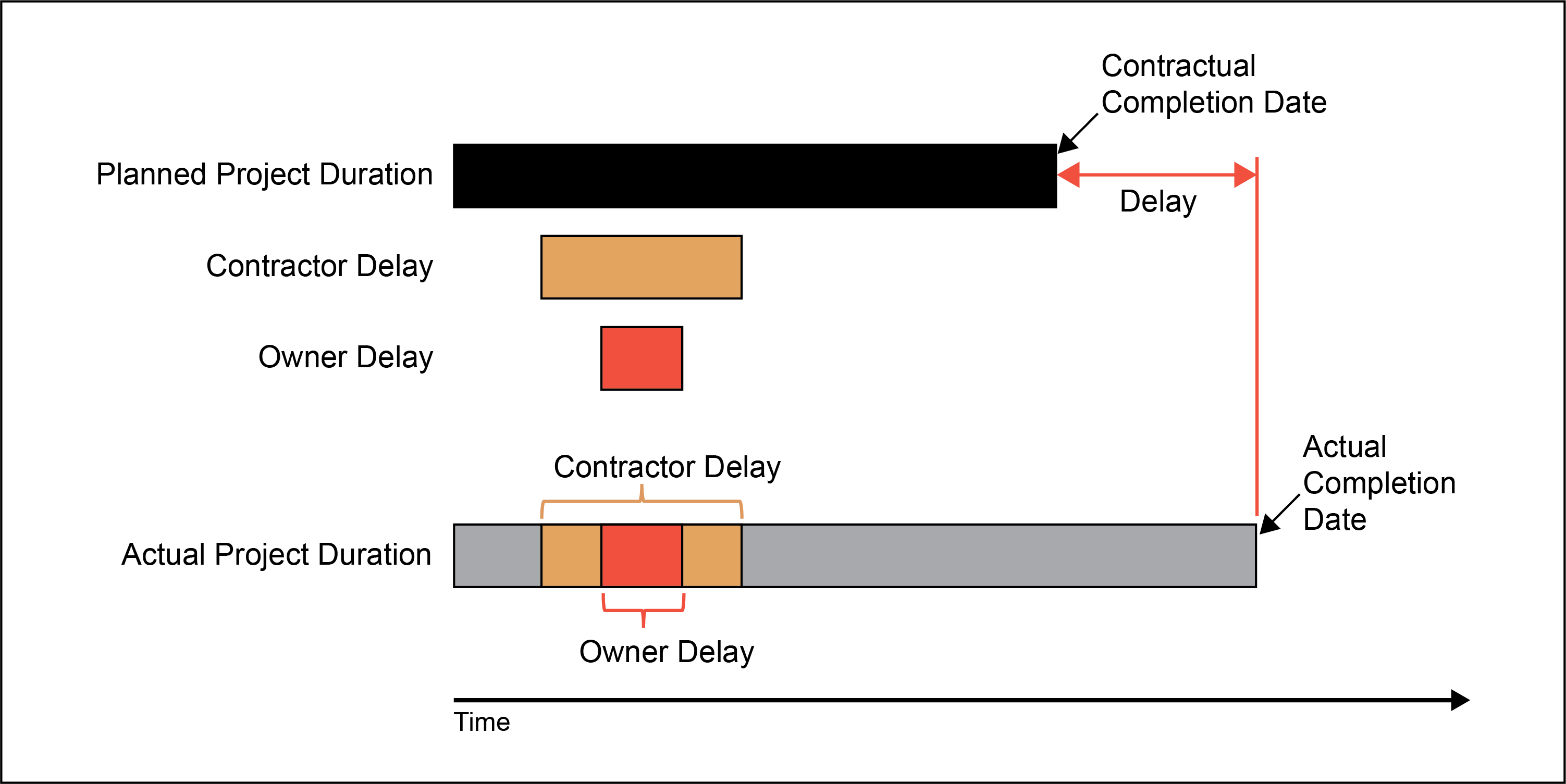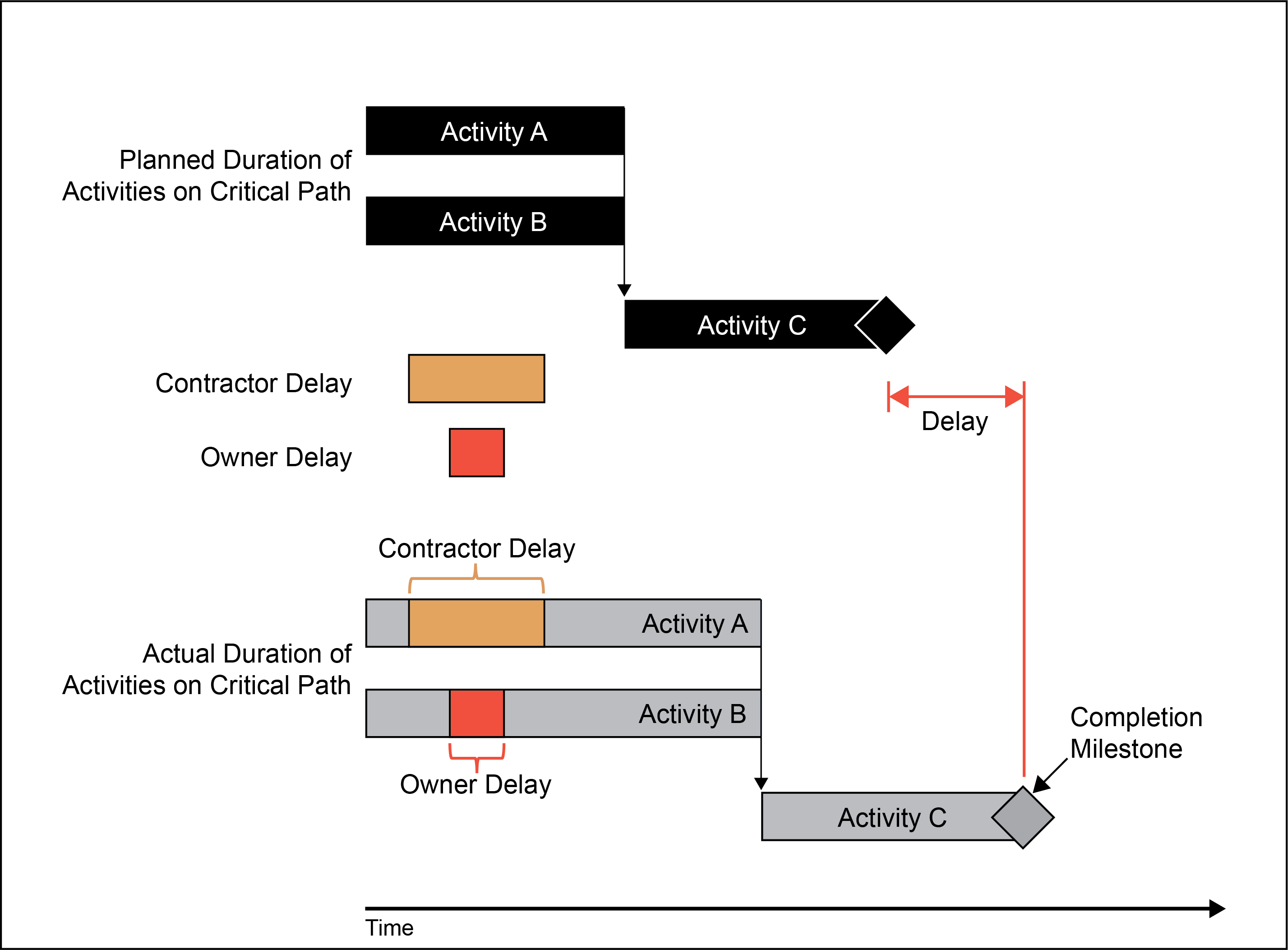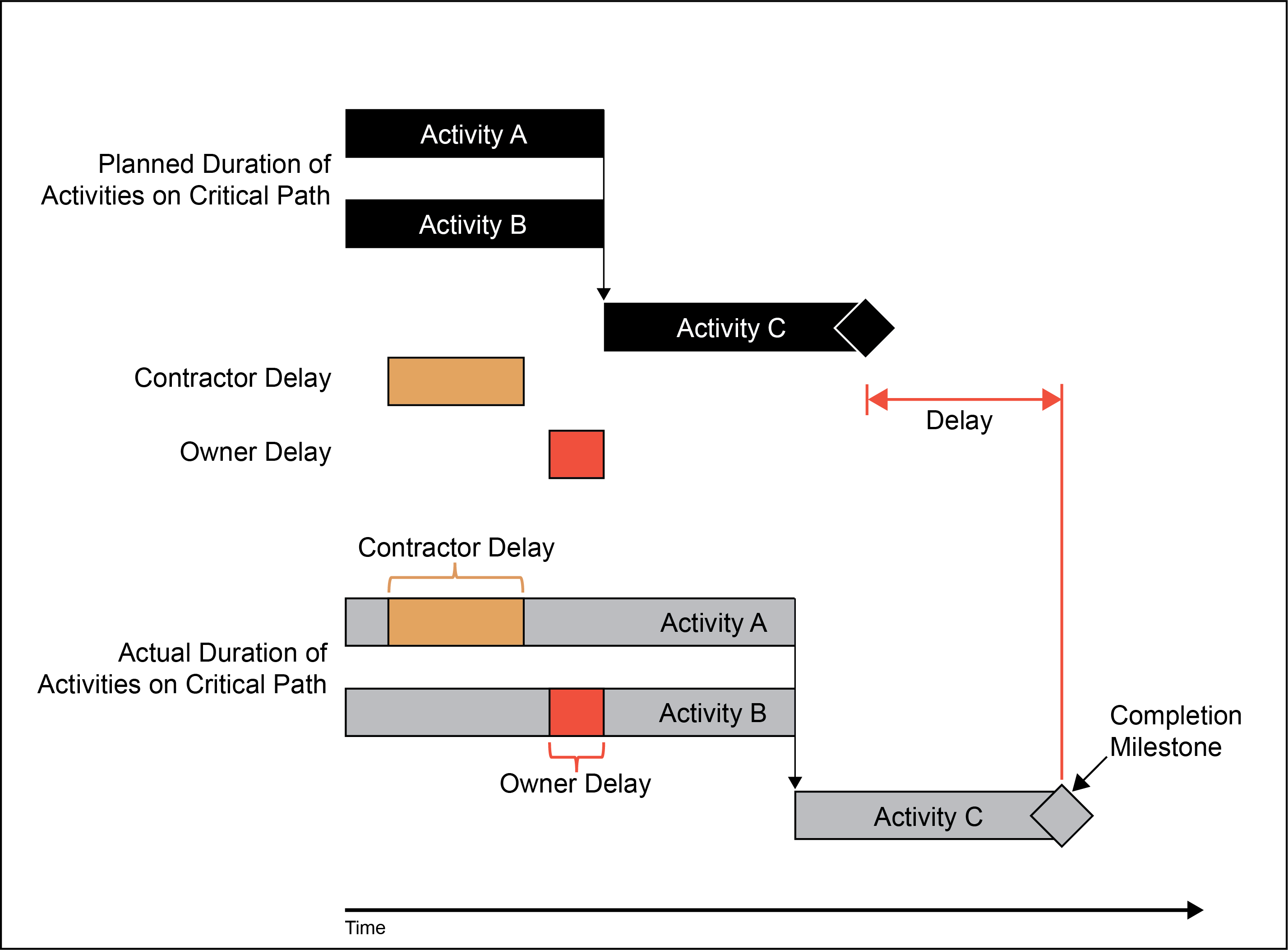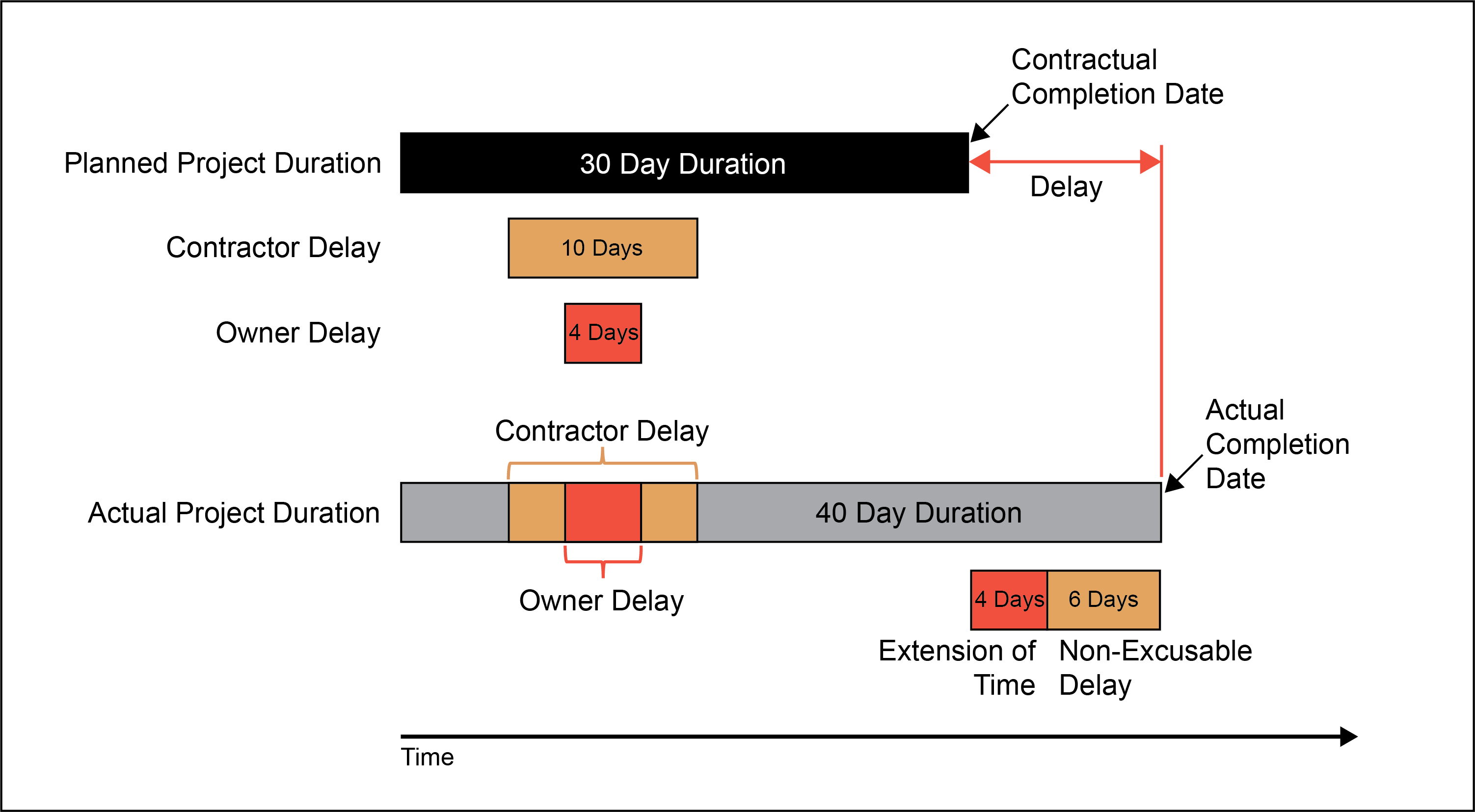Do Losses Really Lie Where They Fall When It Comes to Concurrent Delays?
Concurrency is becoming increasingly common in forensic delay analyses, making the need for a careful review of the contract, as well as the specific facts of each case all the more important. This article discusses the theory behind concurrent delays, their treatment in the context of forensic delay analyses and the recovery of additional costs associated with concurrent delays.
Introduction
In broad terms, delays on construction projects are classified into one of three categories:
- Compensable Delays: delays for which the owner assumes responsibility pursuant to the terms of the contract. These delays generally entitle the contractor to both an extension of time and compensation.
- Excusable but Non-Compensable Delays: delays resulting from so called “neutral events,” which, in other words, are delays whose causes are beyond the control of either party. Such events could be force majeure events, strikes, or unusually severe weather. These delays generally entitle the contractor to an extension of time but no compensation.
- Non-Excusable Delays: delays resulting from the shortcomings of the contractor or its subcontractors. The contractor is generally not entitled to a time extension and may have to accelerate at its own cost. Furthermore, the contractor may have to pay liquidated damages to the owner. Non-excusable delays are non-compensable.
With this in mind, delays on construction projects can arise from any number of causes or events, falling under the responsibility of different parties to the contract. Classifying delays into the above mentioned categories requires a strong appreciation of the facts and a good understanding of the causes of delays on a project.
While these individual delay events and their impacts (classified under any of the above-mentioned categories) may be distinct and isolated, it is also common to see them occur at the same time. Delays occurring at the same time are further broken down into two main types: parallel delays and concurrent delays.
If the root causes of delays occurring at the same time stem from the same party, they are called parallel delays.
If the root causes of delays occurring at the same time stem from more than one party, they are called concurrent delays.
Recommended practices and industry literature outline approaches and considerations for the apportionment of concurrent delays; however, this is often still considered to be one of the more complex aspects of forensic delay analysis.

Figure 1 - Illustration of a simple concurrent delay situation
Concurrent Delays: Basic Definitions
In simple terms, concurrent delays “occur when there are two or more independent causes of delay during the same time period.”1 It is also important to state that each of these delay events must affect the critical path of the project in order to be considered concurrent.2 An illustration of a concurrent delay is shown in Figure 1.
In the example in Figure 1, an owner-caused delay (represented by the period shown in red) occurs concurrently with an contractor-caused delay (represented by the period shown in gold). In this case, the period of concurrency is the duration over which the two delays overlap.
Concurrent delays can stem from many different situations on construction projects. For example, the start of work could be delayed by the owner’s late receipt of regulatory permits or financing, while at the same time, the contractor may be responsible for a late start to construction due to late mobilization of equipment or labour resources. This wide array of situations by which concurrency can present itself has led to the formulation of different definitions of “concurrent delay”.
Simultaneous and Sequential Concurrent Delays
Concurrency can refer to a situation where independent critical delay events occur during the same time period (simultaneous concurrent delays), or it can also refer to delay events arising at “different times but with a common effect”3 (sequential concurrent delays). Sequential concurrent delays4 have also been defined as “those that occur chronologically rather than simultaneously”.5 Figure 2 illustrates these two scenarios for concurrent delays, using an example where delays occur on two parallel activities on the critical path.

Figure 2A - Scenarios of concurrent delays - Simultaneous concurrent delay

Figure 2B - Scenarios of concurrent delays - Sequential concurrent delay
Scenario 1 illustrates a simultaneous concurrent delay situation (similar to the example in Figure 1). As can be seen, a contractor-caused delay (shown in gold) occurs on Activity A at exactly the same time as an owner-caused delay (shown in red) on Activity B. The effects of these delay events are felt at the same time and both impact the successor Activity C.
Scenario 2 illustrates a sequential concurrent delay situation. As can be seen, a contractor-caused delay (shown in gold) occurs on Activity A, and later, an owner-caused delay (shown in red) occurs on Activity B. However, while the delay events themselves are not necessarily occurring at the same time, they have a common impact on the successor Activity C.
It is important to note that while one often thinks of concurrent delays as resulting from independent causes of delay that originate from two (or more) different parties, delays could also be considered as concurrent when, for example, a contractor-caused delay occurs at the same time as an “excusable but non-compensable” delay, such as a force majeure event.6
While the above was intended to provide a basic understanding of the nature of concurrent delays, industry literature, as well as publications and recommended practices from different industry organizations, offer more complete and nuanced definitions of concurrent delays and reflections on their treatment in the analysis of delays.7
Apportioning Concurrent Delays
In general, unless stated otherwise in the contract, concurrent delays are usually treated in a manner similar to the second category of delay mentioned at the beginning of this article – that is, excusable but not compensable.8
A basic example is shown in Figure 3, where the owner-caused delay is shown in red, and the contractor-caused delay is shown in gold.
In this example, the project had a planned overall duration of 30 days. Shortly after work began, a critical 10-day contractor-caused delay occurred. While the contractor delay was still ongoing, a critical 4-day owner-caused delay occurred. As such, these two delays are concurrent with one another. As a result of these concurrent delays, the project ultimately suffered an overall 10 day delay.
As can be seen in Figure 3, typically, an extension of time, without compensation, would be granted for the period of concurrency, in this case, for 4 days. The remaining delay is non-excusable and non-compensable.
In other words, a contractor would be entitled to an extension of time for the impacts of an owner-caused delay or a neutral event (for example, extreme weather) occurring on the critical path during the period of concurrent delay. This is irrespective of the fact that the contractor was experiencing its own delay at the time. The contractor would generally not, however, be entitled to any compensation for that delay. Similarly, unless stated otherwise in the contract, an owner would generally not be entitled to liquidated and/or other delay damages for the period of concurrent delay but would remain entitled to liquidated damages for the non-excusable portion of the delay.
For this reason, concurrent delays are often used as a defense. An owner may invoke concurrent delays to defend against a contractor’s claim for delay-related costs. For its part, although less common, a contractor may invoke concurrent delays as a defense against the owner’s liquidated damages or other delay damages.

Figure 3 - Apportionment of a simple concurrent delay situations
This type of approach seeks to acknowledge impacts to the project schedule without unduly benefiting or penalizing either party financially for delays that both parties contributed to.
While in principle, this seems to be a relatively straightforward way to deal with concurrent delays, its practical application is not always so straightforward. Having said that, there are a number of different theories and approaches generally used in the industry precisely to deal with such situations.
Theories for Apportioning Concurrent Delays
Different theories, or ways of addressing concurrent delays, have been established with a view to giving precedence to one delay event over another when apportioning concurrent delays. Some examples of these are summarized below. A more detailed discussion on the methods used to treat concurrent delays would exceed the scope of this article.
Primacy of Delay
Primacy of delay is based on when delays to the critical path occur. According to this theory, the “first critical delay creates float for all of the other paths to the same milestone and controls the calculation of delay until it is usurped by the next critical event.”9 Based on this, in the context of concurrent delays, the first delay event to occur would create float on other work paths to the same milestone, and therefore would govern.
The Dominant Cause Approach
The Dominant Cause Approach considers the magnitude or significance of concurrent delays to assign more weight to one delay over another. For example, if one delay involves a greater area of the project (in terms of square-footage, number of floors, etc.), is taking place over a longer period of time, or involves more resources, it may be determined to be the governing delay.
The Delvin Approach
The Delvin Approach10 considers a delay event involving breach of contract to be the governing delay in a concurrent delay scenario between delay events of relatively equal significance or impact.
Pacing Delays
Another concept related to concurrent delays is that of pacing, or pacing delays. The Association for Cost Engineering (AACE) International’s Recommended Practice 10S-90 defines pacing delays in the following three ways:
- “Deceleration of the project work, by one of the parties to the contract, due to a delay to the end date of the project caused by the other party, so as to maintain steady progress with the revised overall project schedule.
- A delay resulting from a conscious and contemporaneous decision to pace progress of an activity against another activity experiencing delay due to an independent cause.
- The consumption of float created by another delay, in performing work on an activity not directly dependent on the progress of the work experiencing the other delay.”11
In other words, if one party is causing a critical delay to the project, another party may make the conscious decision to adjust the pace of the remaining work to match the existing delay.12 This may create the appearance of concurrent delays on a project, but it essentially amounts to an intentional concurrent delay situation with a view to mitigating, containing or offsetting the impacts of another delay.
Pacing may be undertaken for numerous reasons, for example, to allow progress to continue on some work fronts not impacted by the existing delay, to reassign resources to other near-critical work, for financial reasons, etc. However, without contemporaneous documentation evidencing the decision to pace, it can be very difficult to prove intentional pacing delays.
Depending on the situation on a given project, the above-mentioned approaches or concepts may not be relevant or appropriate for the apportionment of concurrent delays. As such, it is important to keep in mind that the facts of each case, as well as a careful analysis of the contract language, ultimately guide how concurrent delays are treated.
Recovering Additional Costs
While concurrent delays are generally recognized as being excusable but non-compensable (unless stated differently in the contract), there may be ways for the parties to recover additional costs in the case of concurrent delays.
According to the Society of Construction Law’s Delay and Disruption Protocol, a party could potentially be entitled to recover additional costs incurred as a result of the other party’s delay only if it is able to separate the additional costs caused by the other party’s delay from its own, which can be difficult to do. This would only apply if that party would not have otherwise incurred those additional costs as a result of its own delay.13
These recoverable costs can include direct and indirect costs resulting from delays affecting specific activities, for example:
- Additional direct labour costs or loss of productivity for the impacted activity.
- Extended duration costs associated with the impacted activity, such as prolonged equipment rental costs, prolonged project management or supervision for the impacted activity, etc.
- Costs associated with specific activities pushed into different seasons or working conditions, including unanticipated winter conditions, spring thaw period, etc.
In apportioning responsibility for concurrent delays and associated additional costs, the intention remains to do so as equitably as possible, based on each party’s contribution to the delays. That said, in Canada, no single formal or conclusive approach to apportionment of concurrent delays exists. As such, triers of fact generally rely on the specific facts of each individual case and the evidence presented by the parties.
Where the parties have presented evidence such that the causation and impact of the distinct delays can be assessed to some extent, triers of fact have generally resorted to apportioning concurrent delays “based on the parties’ respective contribution to the delay, with greater [sic] or lesser degree of precision depending on the evidence provided”14, at their discretion. In cases where “the claimed and concurrent delay cannot be apportioned, some courts refuse to award either time or money, while others will grant time but not money.”15 It is also not uncommon, in these cases, for the responsibility for delays to be split equally between the parties.16
Conclusion
The treatment and apportionment of concurrent delays vary in the industry as well as in the courts, in part because they are so fact sensitive. Therefore, in order to address concurrent delays, a careful, methodical approach by an experienced analyst is often necessary to identify, quantify and apportion concurrent delays.
As with any forensic delay analysis, it is of the utmost importance to be mindful of the contract language as well as the facts of each individual case which together will guide the approach to treating concurrent delays.
- Barry B. Bramble and Michael T. Callahan, Construction Delay Claims, Section 1.01 [D], p. 1-22
- Society of Construction Law, Delay and Disruption Protocol, 2nd Edition, p. 29
- W. Stephen Dale and Robert M. D’Onofrio, Construction Schedule Delays, Section 3:9, p. 154
- Also known as offset or consecutive concurrent delays
- Barry B. Bramble and Michael T. Callahan, Construction Delay Claims, Section 11.09, p. 11-164.5
- Steven S. Pinnell, How to Get Paid for Construction Changes: Preparation, Resolution Tools and Techniques, p. 304
- Such as the AACE Recommended Practice 10S-90, SCL Delay and Disruption Protocol, 2nd Edition, etc.
- Note that each delay on its own could be excusable and compensable; however, when such delays are in concurrency, they are conventionally treated in a similar manner as excusable, non-compensable delays.
- AACE International, Technical Paper, CDR-3719 – Concurrency’s Role in Assessing Construction Delay Claims, 2021
- Keith Pickavance, Delay and Disruption in Construction Contracts, Second Edition, p. 14-75
- AACE International, Recommended Practice 10S-90, Cost Engineering Terminology, p. 39
- W. Stephen Dale and Robert M. D’Onofrio, Construction Schedule Delays, Section 3:10, p. 159
- Society of Construction Law, Delay and Disruption Protocol, 2nd Edition, page 39
- Robin Davis, Law column: Concurrent delay remains a thorny issue, April 19, 2017.« Law column: Concurrent delay remains a thorny issue » in On-Site Magazine (April 19, 2017), <https://www.on-sitemag.com/features/concurrent-delay-remains-thorny-issue/>, consulted on 2022-10-03.
- Barry B. Bramble and Michael T. Callahan, Construction Delay Claims, Section 11.09, p. 11-159
- Entreprises P.E.B. Ltée c. Québec (Ville de ), 2002 CanLII 32732 (QC CA), <https://canlii.ca/t/1djn6>, consulted on 2022-10-032002 CanLII 32732 (QC CA).
The Revay Report is published by Revay and Associates Limited, a Canadian firm specializing in construction claims management and dispute resolution services. We assist our clients by bringing clarity to complex issues. Contents may be reproduced with a credit as to source.
The principles presented in this article are those of the author and may not necessarily reflect the view of the company. The author recommends seeking legal advice before applying any principles outlined in this article.
Your comments and suggestions for future articles are most welcome.
Please advise the Montreal office of any change of address or recipient.
Subscribe to
The Revay Report.
You may withdraw your consent at any time by contacting bulletin@revay.com
